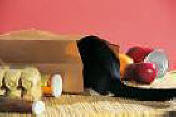|
Need Help?
|
|
Call
1-800-372-3706
to
speak to a Veterinary Behavior Technician |
|
Paws To Speak!
Member Main Menu
|
|
 |
 |
|
Help is at your
fingertips by library, email,
and phone. |
Learn more...
Behavior Modification

A cat is more intelligent than people believe, and
can be taught any crime.
Mark Twain
Notebook, 1895


 |
Surf's Up - Cat Counter Surfing
Solutions
What is it?
Counter surfing is usually fun for cats. On
counters, cat find bright new, shiny objects are just right for pushing off onto the floor,
smells that are out of this world,
even old spills from last nights
dinner, faucets that are dripping
fresh water to drink or bat.
Cats climb and like to be up high so
why shouldn't they jump up on
counters, tables and other
furniture. They are just being
normal cats!
However, you can learn how to
encourage behaviors you want and
help your cat decide to stop
behaviors you don't want such as
counter surfing!
|
Select a
treat that will keep your cat's focused attention. Teach
your cat when he or she is very hungry and relaxed.
|
Why is this a problem?
Unaware cats have been known to jump
up on to a hot stove. Not to
only mention burning fur, have you
considered what chemical residues
from cleaning might be lingering on
the counters, or in the sink?
Not only is it unsafe for cats to
jump on counters, it is not sanitary
after they have been walking in the
litterbox or outdoors.
Body
massage not only teaches the
cat that hands are good
things,
it also teaches the cat to
allow people to take charge
and control any part of his
or
her
body during routine
grooming, exams, treatments,
lifting or moving the cat. |
What to do
If
your cat is counter surfing in hopes
of finding a dripping faucet as a
preference to drinking out of a
bowl, either wash the bowl daily or
provide a pet water fountain for
fresh flowing water.
Cats
like to be up high to survey
territory and explore. Provide your
cat an indoor cat tree and encourage
climbing there by placing cat nip
and treats there. Drag a cat toy up
the tree to give your cat the idea
and help your cat adopt this new
climbing and resting option.
Consider placing the cat tree near a
window unless outdoor stray cats
tend to hang out within sight which
may aggravate your cat.
Then make counters
unappealing by covering them with
tin foil or bubble wrap or sticking
tape so your cat will not enjoy
being there. You can also place
empty soda cans with pennies in them
along the edge of the counter that
will fall and make a big noise to
discourage hopping up on the
counter.
The
idea is to change your cat's
perception of good places to climb
and places that are no longer fun or
friendly such as booby trapped
counters.
Teach
your cat to come when called, sit
when asked and your cat will get
more into a groove of learning to
repeat behaviors that get rewarded
as an alternative to behaviors that
are ignored or result in unwanted
consequences. Be sure YOU are not
the unwanted consequence. Do not
attempt to punish, scold, or yell at
your cat as a teaching method. You
want your cat to be motivated to
learn from you and enjoy being with
you.
|
Learn methods that use brains
not brawn!
|
Teach good behavior using food lures
Similar to a fishing lure,
a food lure moves your cat into
positions you want to teach.
Start with a hungry cat!
Put a tasty morsel of food in your hand and place your hand in front of
your cat's nose to capture your cat's
attention.
Walk
backwards slowly. Does your cat follow the lure?
If so, say,
"Good Kitty.- Come
- Good Kitty" as you move
back then after a few steps, release the food as the
reinforcement.
Begin using the
word, "Come," or whatever specific word you choose every
time you call you cat to you. Only use this word when
your cat is very close and you are sure your cat will
comply. As soon as your cat looks at you - praise.
Praise you cat for any response. Try to say the cue word
once and use praise to encourage the completion of the
behavior.
Behaviors are more likely repeated when they "earn" your loving attention and result in
what your cat wants and values such
as getting fed or lovin'. This is why cats respond to the
sound of a can opener or learn to meow for food and attention.
|
Learning and using gentle methods builds your feline's
intelligence and trust and keeps learning a positive
experience. |
If your cat is doing ANYTHING you wish he or
she didn't do, or is not responding to the
simple lesson above, then consider
making an appointment
with a Veterinary Behavior Consultant based
on a Pet
Behavior
History
Analysis.
The Analysis
helps you understand why your pet acts in
certain ways and what you can do to improve
your cat's behavior at
home using gentle, easy, proven methods.
|
"Helping you raise a fabulous feline
friend for life." |
|